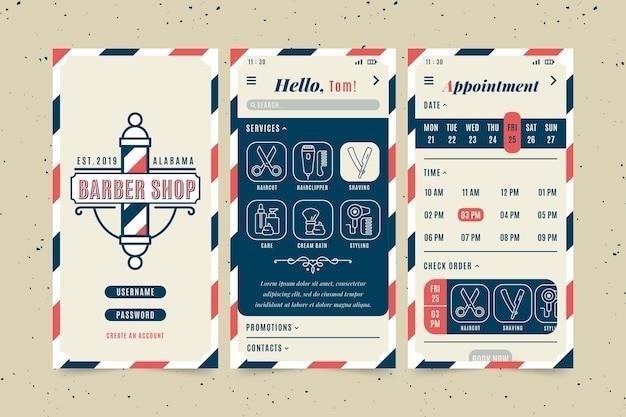Fisher and Paykel Fridge Manuals⁚ A Comprehensive Guide
This guide provides essential information about Fisher and Paykel fridge manuals, covering everything from where to find them to how to use them effectively․ Whether you’re troubleshooting a common issue, understanding your fridge’s control panel, or simply looking for tips on maintenance, this resource has you covered․
Introduction
Fisher & Paykel, a renowned brand known for its innovative and high-quality appliances, offers a wide range of refrigerators designed to meet diverse needs․ Understanding your Fisher & Paykel fridge manual is crucial for maximizing its performance, ensuring efficient operation, and extending its lifespan․ These manuals are comprehensive guides that provide detailed information about your specific model, covering everything from installation and operation to troubleshooting and maintenance․
Whether you’re a seasoned appliance user or new to the world of Fisher & Paykel refrigerators, this guide serves as your gateway to unlocking the full potential of your fridge․ We’ll delve into the importance of these manuals, explore where to find them, and discuss the key information they contain․ By familiarizing yourself with the contents of your Fisher & Paykel fridge manual, you’ll gain a deeper understanding of your appliance, empowering you to make informed decisions and ensure optimal functionality․
Where to Find Fisher and Paykel Fridge Manuals
Accessing your Fisher & Paykel fridge manual is a straightforward process, with various options available to suit your preference․ The most convenient way is to download a digital copy directly from the Fisher & Paykel website․ Simply navigate to their website, locate the “Support” or “Downloads” section, and enter your model number․ You’ll be presented with a list of available manuals, including user guides, installation instructions, and troubleshooting guides․ These digital manuals are readily accessible on any device, allowing you to refer to them at your convenience․
If you prefer a physical copy, you can contact Fisher & Paykel customer support to request a printed manual․ They’ll be happy to send you one by mail, ensuring you have a tangible resource to refer to․ Alternatively, you can check the documentation that came with your fridge when you purchased it․ Often, the manual is included in the packaging, providing immediate access to the essential information․ In addition to these primary sources, you can explore online platforms like Manual․nz, where a vast library of Fisher & Paykel manuals is available, offering a comprehensive resource for various models․
Types of Fisher and Paykel Fridges
Fisher & Paykel offers a diverse range of fridges to suit different needs and preferences․ From compact models ideal for smaller kitchens to spacious side-by-side refrigerators, there’s a Fisher & Paykel fridge to complement any household․ Their lineup includes⁚
- Freestanding Fridges⁚ These versatile fridges are designed to stand independently and offer flexibility in placement․ They come in various sizes and configurations, including single-door, double-door, French-door, and side-by-side models․
- Integrated Fridges⁚ These sleek fridges are designed to seamlessly blend into your kitchen cabinetry, creating a unified and modern aesthetic․ They often feature flush doors that align with surrounding cabinetry, creating a cohesive look․
- Bottom-Freezer Fridges⁚ These models feature a spacious refrigerator compartment above a smaller freezer drawer below․ This design provides easy access to frequently used items while keeping frozen goods conveniently stored․
- CoolDrawer Fridges⁚ Fisher & Paykel’s innovative CoolDrawer technology offers a dedicated drawer for specific food storage needs․ This drawer can be configured as a chill drawer, a wine drawer, or a pantry drawer, providing optimal conditions for various food types․
Fisher & Paykel also offers a range of features and technologies across their fridge models, including ActiveSmart technology, which uses sensors to monitor and adjust temperature and humidity levels, ensuring optimal food preservation․ Their fridges are known for their sleek design, innovative features, and commitment to energy efficiency, making them a popular choice for discerning homeowners․
Common Fisher and Paykel Fridge Models
Fisher & Paykel’s range of fridge models caters to diverse needs and preferences․ Here are some of their popular models, known for their reliability, innovative features, and stylish design⁚
- RF610ADJX7⁚ This freestanding 70/30 American-style fridge freezer offers a spacious 610L capacity, featuring a large refrigerator compartment and a separate freezer section․ Its ActiveSmart technology ensures optimal food preservation, while its sleek stainless steel finish complements any kitchen decor․
- RF540ADUSX4⁚ This model boasts a 540L capacity and a 70/30 configuration, providing ample space for storing groceries and frozen items․ It features a convenient ice maker and a spacious freezer drawer, offering easy access to frozen goods․
- RF521TRPX6⁚ This 521L French-door refrigerator comes with a bottom freezer drawer, offering a sleek and contemporary design․ Its ActiveSmart technology ensures optimal temperature and humidity control, while its spacious refrigerator compartment accommodates a variety of food items․
- RF522ADX5⁚ This 522L side-by-side fridge freezer boasts a spacious design, ideal for larger families․ It features separate refrigerator and freezer compartments, providing easy access to both fresh and frozen goods․ Its sleek design and advanced features make it a popular choice for modern kitchens․
- RB36S⁚ This compact CoolDrawer refrigerator offers a dedicated drawer for specific food storage needs․ It can be configured as a chill drawer, a wine drawer, or a pantry drawer, providing optimal conditions for different food types․
These are just a few examples of Fisher & Paykel’s popular fridge models․ Their diverse lineup offers a range of sizes, configurations, and features to meet the specific needs of every homeowner․
Troubleshooting Common Fridge Issues
While Fisher & Paykel fridges are known for their reliability, occasional issues can arise․ Here’s a guide to troubleshoot some common fridge problems and potential solutions⁚
- Fridge Not Cooling⁚ Check the thermostat setting to ensure it’s at the desired temperature․ If the thermostat is working correctly, inspect the condenser coils for any dust or debris buildup․ Clean the coils regularly to maintain efficient cooling․ Also, verify the fridge door seals for any gaps or damage, as compromised seals can lead to warm air entering the fridge․
- Excessive Noise⁚ Check for loose items inside the fridge that might be rattling against the shelves or walls․ If the noise originates from the compressor, it could indicate a mechanical issue․ Contact Fisher & Paykel customer support for assistance in this case․
- Ice Maker Not Working⁚ Ensure the water supply line is connected and the water filter is not clogged․ Check the ice maker’s settings, ensuring it’s turned on and functioning correctly․ If the ice maker is still not producing ice, a faulty component might be the culprit․ Contact Fisher & Paykel for professional assistance․
- Water Leaking⁚ Inspect the water dispenser for leaks and ensure the water filter is properly installed․ If the leak persists, a faulty water line or a damaged drain pan might be the cause․ Contact Fisher & Paykel for repair services․
These are just some common issues you might encounter with your Fisher & Paykel fridge․ If you can’t resolve the problem yourself, don’t hesitate to reach out to Fisher & Paykel customer support for expert assistance․
Understanding Your Fridge’s Control Panel
Fisher & Paykel fridges often feature intuitive control panels that allow you to adjust settings and optimize your fridge’s performance․ While the specific features and layout might vary depending on your model, here’s a general guide to understanding common control panel elements⁚
- Temperature Controls⁚ These controls allow you to set the desired temperature for both the refrigerator and freezer compartments․ The higher the number setting, the colder it will be․ Adjust the settings according to your preference and the type of food you store․
- Ice Maker Controls⁚ Many Fisher & Paykel fridges have dedicated controls for the ice maker․ You can typically turn the ice maker on or off, adjust the ice cube size, and monitor its status․
- Water Dispenser Controls⁚ If your fridge has a water dispenser, the control panel will include buttons for dispensing chilled water․ Some models might also have a button for dispensing filtered water․
- Other Features⁚ Depending on your model, the control panel might include additional features like a “Vacation Mode” that reduces energy consumption when you’re away, a “Fast Cool” option for quickly chilling items, or a “Child Lock” feature to prevent accidental changes to settings․
Consult your Fisher & Paykel fridge manual for detailed instructions and explanations of your specific model’s control panel․ Understanding the functions of each button and feature will help you maximize your fridge’s efficiency and ensure your food stays fresh and properly stored․
Maintaining Your Fisher and Paykel Fridge
Regular maintenance is crucial for ensuring your Fisher & Paykel fridge operates efficiently and lasts for years to come․ Here are some essential maintenance tasks to perform⁚
- Clean the Interior Regularly⁚ Wipe down the interior shelves, drawers, and door compartments with a mild detergent and warm water․ Regularly clean the drip tray, which collects condensation․ This helps prevent odor buildup and keeps your fridge fresh․
- Clean the Condenser Coils⁚ The condenser coils are located behind the fridge, often at the bottom or back․ Dust and debris can accumulate on these coils, reducing their efficiency․ Vacuum the coils regularly to remove dust and improve airflow․
- Check and Replace the Water Filter⁚ If your fridge has a water filter, check the filter’s lifespan according to the manufacturer’s recommendations․ Replace the filter as needed to ensure clean, fresh water․
- Clean the Door Gaskets⁚ The door gaskets seal the fridge, preventing cold air from escaping․ Clean the gaskets regularly to ensure they are free of debris and grime․ This helps maintain a good seal and prevents energy waste․
- Check for Leaks⁚ Periodically inspect the fridge for any signs of leaks․ Check the water dispenser line, the ice maker, and the drain pan for any leaks․ Address leaks promptly to prevent damage and ensure proper function․
- Ensure Proper Ventilation⁚ Ensure adequate ventilation around the fridge․ Avoid placing the fridge in direct sunlight or near heat sources․ Ensure there is enough space between the fridge and the wall for proper airflow․
Following these maintenance tips will help you keep your Fisher & Paykel fridge running smoothly and efficiently, extending its lifespan and ensuring your food stays fresh․
Safety Precautions and Recommendations
Safety is paramount when using any appliance, and Fisher & Paykel fridges are no exception․ Adhering to these precautions and recommendations will ensure your safety and the longevity of your fridge⁚
- Unplug Before Cleaning⁚ Always unplug the fridge from the power outlet before cleaning or performing any maintenance tasks․ This prevents electrical shocks and ensures your safety․
- Avoid Using Sharp Objects⁚ Refrain from using sharp objects or abrasive cleaners on the fridge’s interior or exterior․ These can scratch or damage the surfaces․
- Keep Children Away⁚ Keep children away from the fridge’s door and control panel․ Children could accidentally open the door or change settings, potentially leading to safety hazards․
- Proper Installation⁚ Ensure the fridge is installed on a level surface and properly connected to a grounded electrical outlet․ This minimizes the risk of electrical accidents․
- Avoid Overloading⁚ Overloading the fridge can strain the motor and reduce its efficiency․ Distribute items evenly and avoid overcrowding the shelves․
- Don’t Block Air Vents⁚ Ensure that the air vents on the back and sides of the fridge are not blocked․ This allows for proper airflow and prevents overheating․
- Regularly Check the Power Cord⁚ Inspect the power cord for any damage or wear․ A damaged cord can pose a fire hazard․ Replace the cord immediately if necessary․
By following these safety precautions, you can ensure that your Fisher & Paykel fridge operates safely and efficiently, providing years of reliable service․
Contacting Fisher and Paykel Customer Support
While Fisher & Paykel fridges are designed for reliability, occasional issues can arise․ If you encounter a problem that you can’t resolve yourself, contacting Fisher & Paykel customer support is the best course of action․ They have a team of knowledgeable experts ready to assist you․ Here’s how to reach them⁚
- Website⁚ Visit the Fisher & Paykel website and navigate to the “Support” section․ You’ll find a wealth of resources, including FAQs, troubleshooting tips, and contact information․
- Phone⁚ You can call Fisher & Paykel’s customer support hotline․ Their number is usually listed on the website or in your fridge’s user manual․
- Email⁚ Many companies offer email support․ Look for a contact form or email address on the website․ Provide detailed information about your issue, including your fridge model number and any troubleshooting steps you’ve already taken․
- Social Media⁚ Fisher & Paykel is active on social media platforms like Facebook and Twitter․ You can try reaching out to them through these channels for assistance․
When contacting customer support, be sure to have your fridge model number and any relevant details about the issue readily available․ This will help them diagnose the problem quickly and provide you with the most appropriate solution․















